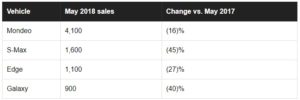Ford Motor Company (NYSE:F) said that its sales in Europe rose 0.6% in May from a very good year-ago result, on strong sales of SUVs, commercial vehicles, and a big jump in sales of the outgoing version of the compact Focus.
Ford has nearly overcome a weak start to 2018 in the Old World, when its all-new Fiesta, a best-seller, was still in short supply. Now that its dealers have ample inventories of the little Ford — and of Ford’s smaller crossover SUVs — the Blue Oval is keeping pace with a growing European market. Year to date, Ford’s sales are down just 0.4% through May.

The raw numbers
Ford reports several sets of sales results for Europe, but two are particularly important. The first is for the 20 Western and Central European centuries that Ford thinks of as its primary market in Europe. (Ford refers to that group of countries as the “Euro 20.”) The second is for all of Europe, including the countries of Eastern Europe, the former Soviet republics, Russia, and Turkey. (Ford calls the second group the “Euro 50.”)

What’s working for Ford in Europe: Small cars and crossovers
Here are the results for Ford’s five best-sellers in Europe in May.

Fiesta sales are off a bit from a year ago. That might seem surprising for a brand-new model that has been in high demand, but consider: Ford has an all-new Focus coming to Europe in a few months, and its dealers are clearing out stocks of the outgoing model. I bet more than a few customers who walked into a European Ford dealership last month intending to buy a new Fiesta in May ended up with a good deal on a one-size-up Focus instead.
Ford’s smaller crossover SUVs also did well in May, a good sign for Ford’s second-quarter profits. The European EcoSport isn’t quite all-new, but it received a significant update for 2018, and sales are up sharply from 2017 levels. The Kuga, the European version of the compact Escape, also had a strong month.
Another positive sign for profitability: Demand for higher-trim Fords is up. While Europeans tend to favor smaller vehicles than Americans, they also tend to order them in plush trims, which give Ford more profit than you’d expect on something like a Fiesta or Focus. Ford said that what it calls “high-series” vehicles made up 69% of its passenger-car sales in the Euro 20 last month, up 6.9 percentage points from May of 2017.
What isn’t working: Ford’s larger vehicles are struggling
While Ford’s Fiesta, Focus, and smaller crossovers are all doing well in Europe, its larger models are struggling.

American readers will be familiar with the Ford Edge, which is the same two-row midsize crossover that Ford sells here in the U.S. What are the others?
- The Mondeo is the European version of the midsize Fusion. In Europe, it’s offered in wagon and hatchback versions in addition to the familiar sedan. (But you’d recognize all three of them right way.)
- The S-Max is a tall wagon based on the Fusion. (You probably know the C-Max, a tall wagon based on the Focus. The S-Max is that, one size up.)
- The Galaxy is closely related to the S-Max, but it’s a little bigger, with three rows of seats to the S-Max’s two. It’s essentially a minivan, but scaled down a bit for Europe. (And it’s not related to the old Ford Galaxie sedan, of course, except in spirit — it’s a big kid-hauler, just as the 1960s Galaxie wagons were.)
Why are sales of all of these vehicles down? Part of the answer may have to do with their drivetrains: All are offered with both diesel and gasoline engines; diesels have become a tougher sell in Europe in the wake of Volkswagen’s emissions-cheating scandal; and the gasoline engines use more fuel per kilometer than the diesels.
Another part of the answer probably has to do with the same big trend we’ve seen in the U.S. and China: More buyers are choosing crossover SUVs. The Kuga’s recent success could be coming at the expense of the S-Max and Mondeo to some extent.
The upshot: On balance, things are looking pretty good
Ford’s first-quarter result in Europe was mixed, in large part because of the Fiesta. The all-new version of Ford’s European best-seller drove an improvement in net pricing, but sales were down because supplies were still tight.
More broadly, that trend away from diesel engines, which in Ford’s lineup tend to be part of higher-profit packages, and unfavorable exchange-rate movements didn’t help, either. The upshot was a $90 million drop in profit in the first quarter, to $119 million.
We still don’t know how the diesel issue will affect Ford on an ongoing basis, and we don’t quite know how the exchange-rate story will play out in the second quarter. But within the things Ford can control, the signs are good: Sales of the new Fiesta continue to be strong, and more buyers are choosing higher-profit trims.
Assuming those trends continue in June, Ford has a good chance of improving on the $88 million in profit it earned in Europe in the second quarter of last year.
This article originally appeared on Motley Fool.


